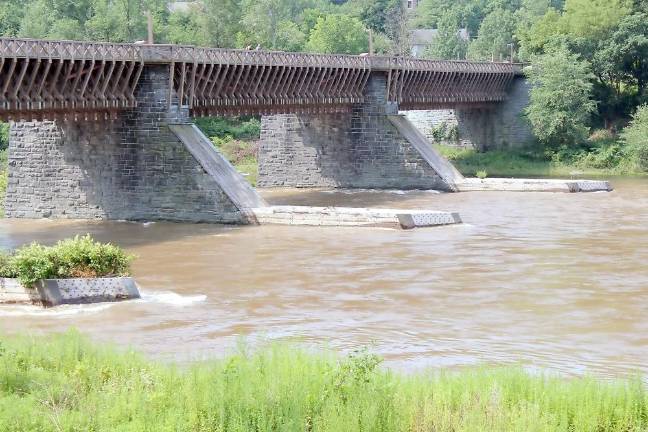Delaware River advocates say Trump rollbacks are the 'worst in the Clean Water Act’s history'
Milford. The Coalition for the Delaware River Watershed says the ending of federal protections leaves many waterways vulnerable to pollution. The Trump rule narrows the Obama administration's 2015 definition of what's a protected body of water and effectively removes safeguards for some waterways that had been put into place with the 1972 Clean Water Act.

(AP) The Trump administration on Jan. 23 ended federal protection for many of the nation's millions of miles of streams, arroyos, and wetlands, a sweeping environmental rollback that could leave the waterways more vulnerable to pollution from development, industry, and farms.
The policy change, signed by the heads of the Environmental Protection Agency and U.S. Army Corps of Engineers, narrows the types of waterways that qualify for federal protection under the half-century-old Clean Water Act.
“The administration’s cutbacks on the environmental protections afforded by the Waters of the United States Rule is the worst in the Clean Water Act’s history," said Sandra Meola, director of the Coalition for the Delaware River Watershed in a statement. "Many streams, rivers, and approximately half of the nation’s wetlands will be left federally unprotected."
Protections for ephemeral streams, which flow only after rain or snow, will also be erased, though they account for 18 percent of streams in the United States, she said.
"Though they flow only briefly, ephemeral streams can carry pollution downstream into larger water bodies, polluting wildlife habitat and drinking water sources," said Meola. "As communities across the country, including those in the Delaware River Watershed, try to clean up polluted drinking water sources and maintain critical wetland habitat, now should be the time for the federal government to provide robust safeguards for our nation’s waterways."
The Coalition for the Delaware River Watershed is a network of over 150 non-governmental organizations in New Jersey, New York, Pennsylvania, and Delaware dedicated to protecting and restoring the natural resources of the Delaware River Basin.
'Ridiculous regulations'
Since his first weeks in office, President Donald Trump has targeted environmental and public health regulations that he says imposed unnecessary burdens on business. Speaking to farmers in Texas, Trump repeated his frequent charge that an Obama-era attempt in 2015 to more clearly define what water bodies qualify for federal pollution protection was "one of the most ridiculous regulations of all."
The changes to the clean water rule have long been sought by builders, oil and gas developers, farmers, and others. But environmental groups and public-health advocates say the rollback will allow businesses to dump pollutants into newly federally unprotected waterways and fill in some wetlands, threatening public water supplies downstream and harming wildlife and habitat.
EPA head Andrew Wheeler said states were still free to step in with state protections of newly vulnerable waterways if they chose.
"Our rule protects the environment and our waterways while respecting the rights of states and property owners,'' Wheeler said. The rollback of the clean-water enforcement "strikes the proper balance between Washington, D.C., and the states,'' he said.
Brett Hartl, a government affairs director with the Center for Biological Diversity conservation advocacy group, called the changes "a sickening gift to polluters.''
The administration's action "will allow wetlands, streams and rivers across a vast stretch of America to be obliterated with pollution,'' Hartl said, contending the rollback would speed extinction for dozens of endangered species. "People and wildlife need clean water to thrive. Destroying half of our nation's streams and wetlands will be one of Trump's ugliest legacies.''
Safeguards removed
The Trump rule narrows the Obama administration's 2015 definition of what's a protected body of water and effectively removes safeguards for some waterways that had been put into place with the 1972 Clean Water Act.
The administration says the changes would allow farmers to plow their fields without fear of unintentionally straying over the banks of a federally protected dry creek, bog, or ditch. But the government's own figures show it is real estate developers and those in other nonfarm business sectors that take out the most permits for impinging on wetlands and waterways, and stand to reap the biggest regulatory and financial relief.
Environmental groups said the draft version of the rule released earlier would have lifted federal protections for roughly half of the nation's wetlands and one-fifth of the millions of miles of waterways. The administration challenges that estimate and says it is not possible to come up with a solid figure for how much of the nation's surface water will be affected.
One of the biggest changes applies to so-called ephemeral waters -- creeks and rivers that run only after rainfalls or snow melt. Such streams provide a majority of the water for some dry Western states.
"That''s a huge rollback from way before Obama, before Reagan," said Blan Holman, a senior attorney with the Southern Environmental Law Center.
Another key change removes federal protections for wetlands deemed not directly connected to a major waterway. Geoff Gisler, senior attorney at the Southern Environmental Law Center, said it appears millions of acres of the wetlands on the Southeastern coast alone -- vital buffers against flooding and climate change -- would lose protections, as would so-called prairie pothole wetlands in the middle of the country, and others.
The final rule will be published in the Federal Register in the next few days and become effective 60 days after that.
Environmental groups and some states are promising legal challenges. But Gisler fears developers and others will take the Jan. 23 announcement as a signal, and move quickly -- "get the bulldozers lined up, and on day 61 fill in streams and wetlands," he said.
Associated Press writers Ellen Knickmeyer, Susan Montoya in Albuquerque, New Mexico, and Tammy Webber in Chicago contributed to this report.
Online: The Coalition for the Delaware River Watershed: DelRiverWatershed.org.